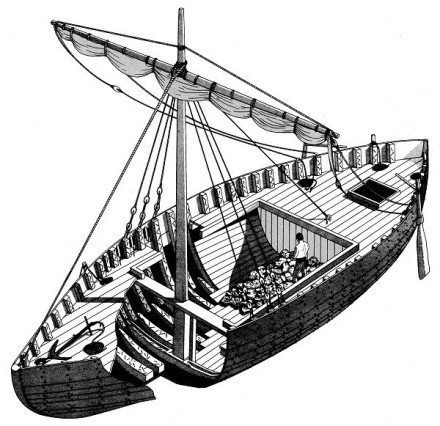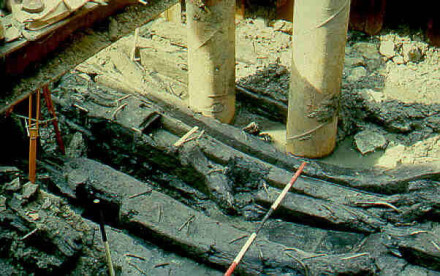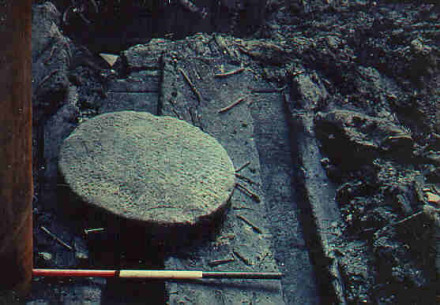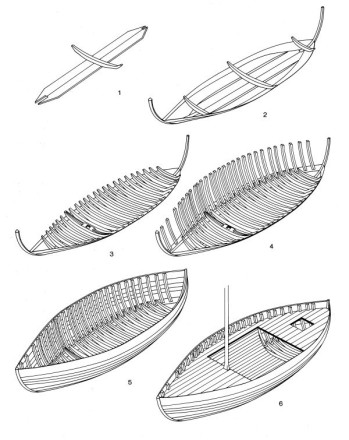History
Romano-Celtic ship in London
Remains of a Roman-era ship were discovered by Peter Marsden in 1962 in the bed of the River Thames, off Blackfriars in the City of London, and excavated in 1962-1963. it got the name Blackfriars Ship 1. It was a wreck that lay about 120 metres from where the shore would have been in Roman times at the south-west corner of the Roman city of Londinium. The remains of the forward half of the ship and the extreme aft timbers were excavated. The forward half had been damaged during modern construction work. The aft half remains unexcavated. Some timbers are preserved at the Shipwreck Heritage Centre, Hastings, and in the Museum of London.

The wreck comprised the bottom and parts of the collapsed sides of a Romano-Celtic ship. The vessel was built of oak timber and had no keel, but instead two broad keel planks.
A stem post lay at the bow and a stern post at the stern. The planks were carvel laid and fastened by large iron nails to oak frames - massive floo timbers in the bottom, and lighter side frames at the sides. The bottom nails had partly cone-shaped heads hollowed to contain a caulking of thin slivers of hazel wood in pine resin, and the sides had fully cone-shaped heads which were similarly caulked. The pointed ends of all nails had been turned over the inboard face of the frames (clenched). Between the strakes there was a caulking of hazel shavings in a pine resin.
The mast step was a rectangular socket in a transverse floor timber about one-third of the length of the vessel from the bow, and in the bottom of the step was a votive offering of a worn bronze coin of Domitian that had been minted in Rome in AD 88-89. The construction of the ship was dated to about AD 150 by dendrochronology, and its sinking was dated soon after that by associated pottery and a coin.

Cargo
The wreck was carrying a cargo of building stone by the rivers Medway and Thames from the Maidstone area of Kent, south-east England, to London. Forward of the mast step in the bottom was an unfinished millstone of Millstone Grit, probably either from the Pennine Hills of northern England or, more likely, from the Namur region by the river Meuse in Belgium.
The ship had certainly sailed at sea for traces of shipworm and Limnoria borings existed in the planks. It appears to have sunk in a collision.

Description
The hold was positioned in the middle of the ship and was lined with a ceiling of oak planks.

| Length | 46 feet (14 m) |
|---|---|
| Width | 21 ¼ feet (6.5 m) |
Status
The remains of the forward half of the ship and the extreme aft timbers were excavated, yet part of the forward half was destroyed during modern construction work. The aft half remains unexcavated. Part of the timbers are preserved at the Shipwreck Heritage Centre, Hastings, and in the Museum of London.
References
- Peter Marsden (1994).
Ships of the Port of London, first to eleventh centuries AD.
English Heritage archaeological report 3. - The NAVIS I project.
Blackfriars 1.